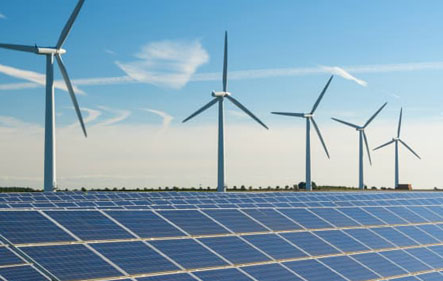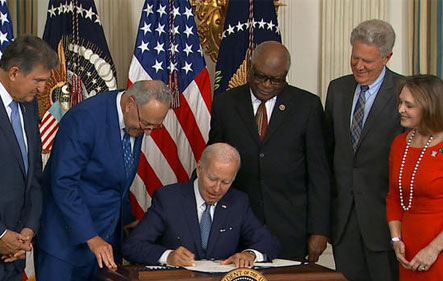Congress finally came together (however reluctantly) to take action on climate change. Thanks to the Biden Administration, fighting the battle against climate change is back on the menu, in the form of the Inflation Reduction Act.
Once considered DOA, the Inflation Reduction Act will put the US on the path to reducing greenhouse gasses by as much as 40% below 2005 levels by 2030, within striking distance of President Biden’s 50% reduction goal set under the Paris Agreement.
The Inflation Reduction Act, or IRA (no, not the retirement savings plan) will raise over $700 billion in revenue within 10 years, paying for itself while simultaneously reducing the deficit over time.
Highlights:

- The IRA provides for over $430 billion to reduce carbon emissions, while also extending health insurance subsidies under the Affordable Care Act.
- $30 billion in tax credits earmarked to speed production of solar panels, wind turbines, batteries, and critical minerals processing.
- Tax credits of $10 billion set aside to build facilities for essential clean energy products like electric vehicles and solar panels.
- That increasingly popular Defense Production Act will have yet another moment in the sun: $500 million available for heat pumps and critical minerals processing.
- One of the best IRA perks -- $60 billion earmarked to help disadvantaged areas disproportionately affected by climate change. $27 billion of that would be set aside to create the first national “Green Bank” to help foster investment in clean energy projects in disadvantaged areas.
- $1.5 billion set aside for oil companies to reduce GHG emissions. Double edged sword --- it will also penalize them for failing to do so. Penalties of up to $1500 per ton will be levied against companies for excess leaks of methane.
- The IRA will also provide a space for further development of “bridge” technologies – carbon sequestration, hydrogen, and small nuclear reactors. You may not be a fan, but experts believe they are essential to getting America to the goal of net-zero emissions by 2050.
- Bumping the ban: A 10-year moratorium on offshore wind leasing established under the Trump administration is history thanks to the Inflation Reduction Act.
One of the not-so-great parts of the IRA is the change to tax credits for electric vehicles (EVs). The 200,000 cap on credits for vehicles sold is being lifted – great news for Tesla and GM. But the downside on qualifying for the $7,500 federal credit is new income caps, and limiting the credit to sedans costing $55,000 or less and other EVs priced at under $80,000.

If your income and your new EV fall within these requirements, you get a tax credit … maybe. Your income and the cost of your EV of choice aren’t the only qualifiers. Your car battery has to be stamped “Made in America”. Not only that, at least 40% of materials used must have been extracted and processed in this country, or in a country we have a free trade agreement with.
Fortunately, auto and battery makers are building factories in the US. Tesla has a Nevada plant, GM is in Ohio. And Ford and Volkswagen are in Georgia. But the materials requirement may be the real tax credit-killer. Today, almost all the world’s graphite, two-thirds of the world’s lithium, and much of the cobalt is processed in China.
Okay, so the IRA isn’t perfect. We know that (offshore leasing provision) is controversial to say the least. But you have to give this one to Biden. He has scored the most comprehensive and consequential Climate Change legislation since the Clean Air Act back in 1970.

So who wins? Not the Republicans. Not the Democrats (okay, well maybe, but ..). We do. We ALL win. But what does that win look like. Will massive flooding go away overnight? No. Will chronic drought be a thing of the past. Not soon enough. Will year-round fire season soon be an unpleasant memory? I wish. But what this legislation does, hopefully, is keep things from getting even worse while setting us on a path to healing the environment. Change won’t happen overnight, but it will happen. That is, it will if we, as a nation, and as a world, keep working to pull ourselves away from the climate catastrophe cliff that we’ve been racing toward for far too long.
END

